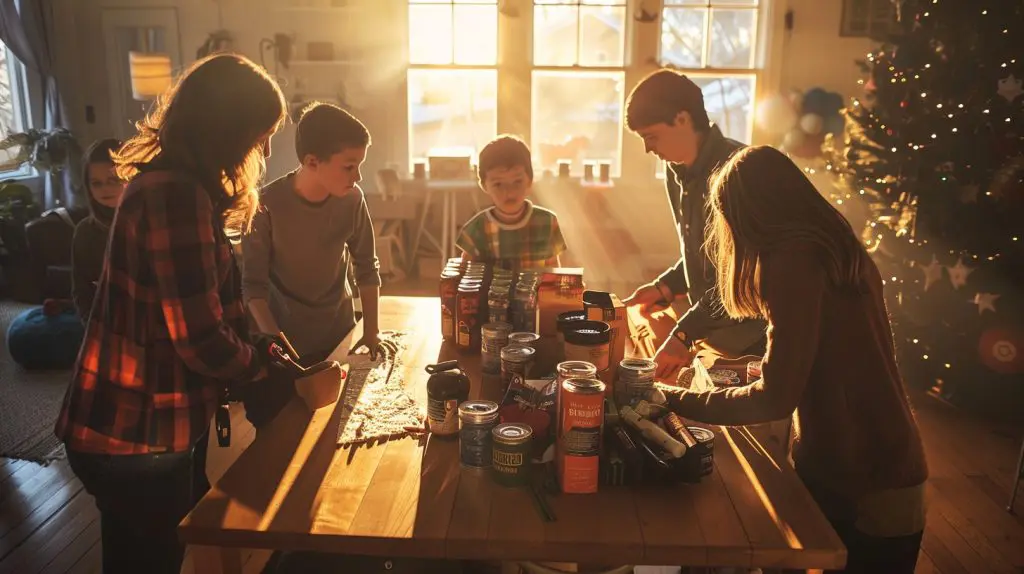Prepping for the Whole Family

When prepping for the whole family, considering everyone's needs, including your pets, is vital. You can't just focus on food; think about essential supplies and emergency plans. Engage your family in inventory checks and discussions about their favorite meals to guarantee everyone feels included. Have you ever considered teaching kids basic cooking skills that could transform your kitchen dynamics? It promotes independence and creativity, and that's just the beginning. What strategies will you use to balance preferences and maintain a well-stocked pantry that keeps everyone happy and healthy? Let's explore this further.

Assessing Family Needs
When evaluating family needs for emergency prepping, it's crucial to frequently consider everyone's dietary preferences and restrictions, as this guarantees that your food supplies will meet the nutritional requirements of each family member.
Start by identifying any food allergies, vegetarian needs, or gluten-free requirements. This guarantees that when emergencies arise, you're not scrambling to accommodate these needs.
Engaging your family in open discussions about their favorite meals is a practical way to guarantee that your plan aligns with their tastes. It's not just about survival; it's about maintaining a sense of normalcy and comfort during challenging times.
Encourage everyone to share their favorite meals, which can lead to a more enjoyable experience when using your prepped food. This approach fosters belonging and makes everyone feel valued in the process.
Consider conducting a family survey or setting up regular brainstorming sessions. These activities can provide valuable insights into meal preferences, helping you diversify your menu and minimize food waste.
Additionally, evaluating your family's schedule will help you plan meals that fit around busy days. This strategic planning guarantees you utilize leftovers efficiently, saving time and resources.
Pay attention to portion sizes and meal satisfaction as well. Keeping track of what works and what doesn't will refine your meal planning, guaranteeing it meets everyone's needs.
Building a Supply Inventory
Building a supply inventory can seem intimidating, but breaking it down into manageable steps makes it efficient and straightforward. Begin by conducting a thorough inventory of your pantry, fridge, and freezer every few weeks. This routine helps you identify what you already have and what needs replenishing. Not only does it minimize waste, but it also aids in better meal planning—a vital aspect for any family looking to stay prepared.
Next, create a master list of staple items your family regularly consumes. Include essentials like grains, proteins, vegetables, and snacks. This list will streamline your grocery shopping, guaranteeing you maintain a well-stocked kitchen without being overwhelmed by overbuying or missing essential items.
As you shop, organize your inventory by categorizing items into groups, such as canned goods, fresh produce, and frozen items. This categorization will help you quickly locate what you need when meal prepping.
Regularly checking expiration dates on stored items is another key practice. Watch for anything nearing its end during your inventory assessments, and plan meals around those items. This reduces food waste and guarantees your family is consuming fresh and safe ingredients.
Use your supply inventory to inspire your meal planning. Choose recipes that incorporate what you already have on hand. This approach promotes cost-effectiveness and allows for creativity in cooking.
Creating an Emergency Plan

Creating an effective emergency plan is essential in guaranteeing your family's safety during unforeseen events. Start by assembling an emergency kit containing water, non-perishable food, first-aid supplies, flashlights, batteries, and vital documents. Make sure it's easily accessible to everyone in your household. It's not just about having supplies; it's about readiness and peace of mind.
Next, conduct regular drills. Practicing these procedures will help your family react quickly when every second counts. Familiarity breeds efficiency, so ensure drills are routine. This also fosters a sense of unity and preparedness among family members, which is particularly reassuring in stressful situations.
Don't forget to keep a list of emergency contacts. This should include local authorities, medical facilities, and key family members. Ensure everyone knows where to find this information, whether a printed list or stored digitally. An up-to-date contact list can be a lifeline when communication networks are strained.
Review and update your emergency plan at least once a year. Consider changes like new family members, updated contact information, and any new risks that might arise—staying current guarantees that your plan remains practical and relevant.
Finally, while communication strategies will be covered separately, remember that designating a meeting point can be vital if you're ever separated. The sense of belonging and security this provides can't be overstated.
Communication Strategies
While having a solid emergency plan is essential, effective communication strategies are just as crucial for guaranteeing your family's safety and unity during emergencies. Communication fosters a sense of belonging and guarantees everyone's voice is heard. Start by establishing regular family meetings where everyone's input is valued. Discuss meal preferences and schedules—this practice prepares you for unexpected situations and strengthens family bonds.
Utilize technology to your advantage. A shared calendar or digital platform can help you keep track of meal prep days, grocery shopping, and family events. This transparency promotes organization and reduces misunderstandings. Encourage open dialogue about dietary restrictions or preferences, allowing family members to express their needs. Collaboration on meal choices can accommodate everyone's requirements and enhance teamwork.
Assigning specific roles during meal prep is another effective strategy. This fosters responsibility and teaches children valuable cooking skills. It's a practical way to guarantee everyone is committed to the family's well-being.
Create a family meal planning board where ideas for meals and snacks can be freely shared. This not only enhances engagement but also adds excitement to food preparation. You can build a cohesive and resilient family unit by incorporating these strategies.
Here's a quick reference table to help you keep track:
| Strategy | Benefits | Tools Needed |
|---|---|---|
| Regular Family Meetings | Encourages communication | None |
| Shared Digital Calendar | Promotes organization | Smartphone or computer |
| Assign Roles | Builds responsibility | Meal plan, cooking equipment |
| Meal Planning Board | Enhances engagement | Bulletin board, sticky notes |
Skills for Self-Sufficiency
Involving your whole family can make all the difference when prepping for self-sufficiency. Teaching everyone essential skills enhances independence and fosters a sense of unity and readiness.
In the kitchen, start by teaching basic cooking skills. Show your family how to chop vegetables and measure ingredients. This not only builds independence but also instills confidence in their abilities.
Meal planning is another important skill. Get the family involved in deciding what's on the menu. This encourages responsibility and gives everyone a better understanding of nutrition. Plus, it makes meal times something to look forward to as each member sees their choices come to life.
Creating a weekly grocery list together is a practical exercise in budgeting and planning. It teaches the importance of thinking ahead and guarantees you have everything needed for your meals. It's also an opportunity to discuss the value of money and how to make it stretch further.
Engaging everyone in food preparation tasks, like washing produce or assembling sandwiches, helps develop fine motor skills and boosts confidence.
Encourage creativity by letting them experiment with ingredients and flavors. This adaptability is vital for self-sufficient meal preparation and can lead to delightful culinary surprises.
Involving Children in Prepping

Involving children in prepping is a practical way to foster their independence and enhance their understanding of self-sufficiency. By engaging them in activities like meal preparation, you teach them essential life skills and create opportunities for family bonding. Children who take part in meal prep are more willing to try new foods, which can lead to healthier eating habits. Please encourage them to wash vegetables or mix ingredients; these simple tasks build their confidence and culinary skills.
Consider using the following table to highlight the benefits of involving children in prepping:
| Activity | Emotional Benefit |
|---|---|
| Helping with meal prep | Builds confidence and curiosity |
| Assembling their own lunches | Fosters independence and pride |
| Choosing ingredients | Boosts creativity and ownership |
| Family cooking sessions | Strengthens relationships |
| Learning food prep skills | Encourages healthy eating habits |
Involving kids in prepping isn't just about food. It's an opportunity to teach them about emergency preparedness in an engaging and age-appropriate way. Help them build an emergency kit by selecting non-perishable foods or packing a flashlight. These activities make them feel valued and part of the family team.
Preparing for Pets

Caring for your furry family requires thoughtful meal prepping to guarantee they get the nutrition they need. Start by consulting your veterinarian to tailor meals to your pets' specific dietary needs based on age, size, and health conditions. This makes certain you're meeting their nutritional requirements effectively and safely.
Consider incorporating fresh, whole ingredients like lean meats, vegetables, and grains when prepping meals. These components can significantly enhance your pets' health and well-being, providing them with balanced nutrition. Batch cooking these meals can save you time and ensure consistency, vital for maintaining your pets' health.
Remember, prepped meals can reduce the temptation to fall back on unhealthy snacks or takeout options, keeping your pets' diet wholesome.
Organization is key. Store meals in labeled containers with precise expiration dates. This practice helps prevent spoilage and allows you to track and manage your pets' meals effortlessly. Having meals prepped and stored makes sure that, even during busy days, your pets won't miss out on fresh and nutritious food.
Meal prepping for pets is more than just a task; it's a way to express care and commitment to their well-being. By planning and preparing their meals, you foster a sense of belonging and security within your family unit.
Your pets, much like any other family member, deserve the best. By making certain they receive healthy, balanced meals, you're contributing to their happiness and longevity.
Regular Plan Updates

As you guarantee your pets are well-fed with nutritious prepped meals, keeping your family's meal plan up to date is equally important. Regularly renewing your meal plans every few weeks can make a significant difference in maintaining enthusiasm for healthy eating. Updating these plans will introduce variety and excitement to mealtime, keeping everyone engaged and satisfied.
Incorporating seasonal ingredients is a smart strategy when revising your meal plans. Not only do these ingredients enhance flavor, but they also support local agriculture and often come at a lower cost. This choice benefits your family and strengthens your community's economy, creating a sense of belonging.
To guarantee everyone's preferences are considered, organize family brainstorming sessions. These gatherings foster engagement and collaboration, encouraging each member to contribute ideas and preferences. When everyone feels heard, there's a greater chance of meal acceptance and enjoyment.
Don't forget to adjust the meal plan based on feedback. Listen to what your family says about the meals, whether about taste, portion sizes, or dietary restrictions. This feedback loop creates a more inclusive and supportive cooking environment, promoting health goals for each member.
Reassess dietary needs and preferences every few months to guarantee your plan aligns with evolving health requirements. This practice ensures that your family feels supported and included, prioritizing their well-being.
Regular updates to your meal plan enhance the quality of your meals and strengthen family bonds, fostering a nurturing and united household.
Closing Thoughts
To successfully prep for your family, focus on understanding everyone's needs and maintaining a well-stocked inventory. Develop a thorough emergency plan and guarantee open communication among all members. Encourage self-sufficiency by teaching essential skills and involve children in the process to make it engaging. Don't forget to include your pets in the plan. Regularly update your strategies to adapt to changing circumstances and preferences, ensuring your family's preparedness and well-being are always prioritized.


